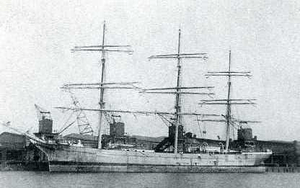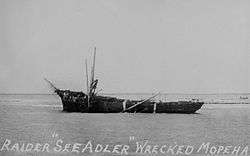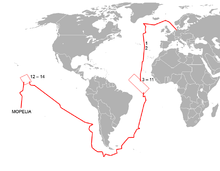SMS Seeadler (1888)
 Pass of Balmaha, later SMS Seeadler | |
| History | |
|---|---|
| Name: | SMS Seeadler |
| Namesake: | sea eagle |
| Ordered: | 1888 as Pass of Balmaha |
| Builder: | R Duncan & co |
| Launched: | 1888 |
| Acquired: | 1915 |
| Commissioned: | 1915 |
| Fate: | Wrecked 2 August 1917 |
| General characteristics | |
| Displacement: | 4500 tons (1,571 GRT) |
| Length: | 83.5 m |
| Beam: | 11.8 m |
| Draught: | 5.5 m |
| Installed power: | 900 hp |
| Propulsion: | 1 shaft auxiliary diesel engine |
| Sail plan: | 3 masts, full rig, 2,600 square metres (28,000 sq ft) sail area |
| Speed: | 9 knots (17 km/h) |
| Complement: | 64 |
| Armament: | 2 × 105mm guns, 2 x machine guns, 2 x torpedo tubes |
- This page is about a commerce raider. For the World War I cruiser, see SMS Seeadler.
SMS Seeadler (Ger: sea eagle) was a three-master windjammer. She was one of the last fighting sailing ships to be used in war when she served as a merchant raider with Imperial Germany in World War I. Built as the US-flagged Pass of Balmaha, she was captured by the German submarine SM U-36, and in 1916 converted to a commerce raider. As Seeadler she had a successful raiding career, capturing and sinking 15 ships in 225 days until she was wrecked, in September 1917, in French Polynesia.
Pass of Balmaha
The ship was launched as Pass of Balmaha by Robert Duncan & Company, Port Glasgow, Scotland, on 9 August 1888 as a 1,571 GRT steel-hulled ship-rigged sailing vessel.[1][2] She was 245 feet (75 m) long, 39 feet (12 m) in beam and with a depth of 23 feet (7.0 m). Delivered in the following month to the ownership of David R Clark, a partner in Gibson & Clark, Glasgow, she was registered at that port with Official Number 95087 and signal letters KTRP.[2][3]
In February 1908, Pass of Balmaha was sold at Leith by Gibson & Clark for £5,500.[4] By 1910, she was owned by Ship Pass of Balmaha Co Ltd, Montreal, and under the management of George I Dewar, Toronto, though Glasgow remained her port of registry.[5]
It is believed she was later owned by the Harris-Irby Cotton Company, Boston, and sailed under the US flag.
Capture
Pass of Balmaha was captured by U-36 in the North Sea in 1915 under somewhat peculiar circumstances. New York Harbor in June 1915, bound for the Arctic port of Arkhangelsk with a cargo of cotton for Russia. She was intercepted by the British auxiliary cruiser Victorian off the coast of Norway. Victorian's captain led a boarding party to inspect the cargo for contraband. The British captain found reason for suspicion, and ordered Pass of Balmaha to sail to Kirkwall in the Orkney Islands for further inspection. A prize crew of an officer and six marines was left aboard to ensure compliance.
The British also ordered the neutral American colours struck and replaced with the British flag, against the will of Pass of Balmaha's Captain Scott, who realised that this would mark the ship as a belligerent. Soon after, U-36 intercepted Pass of Balmaha. To avoid being impounded, Scott hid the British prize crew in the hold and replaced the Union Jack with the Stars and Stripes. The commander of the U-36, Captain Ernst Graeff, was not entirely convinced by this ruse and ordered Pass of Balmaha to sail for Cuxhaven for inspection. A German ensign was left aboard. Scott and his crew, resentful of what they perceived as British meddling, kept the British marines locked in the hold.
Pass of Balmaha reached Cuxhaven without major incident, and was boarded by a German inspection party. Captain Scott then revealed the British prize crew to the Germans, who took them prisoner. For their cooperation, the Americans were allowed free passage to a neutral country, but Pass of Balmaha became property of the German Navy.[6]
SMS Seeadler

By 1916 the Allies had blockaded German warships in the North Sea, and any commerce raiders that succeeded in breaking out lacked foreign or colonial bases for resupply of coal. This gave rise to the idea of equipping a sailing ship instead, since it would not require coaling.
The Seeadler was equipped with an auxiliary engine, hidden lounges, accommodation for additional crew and prisoners, two hidden 105 mm cannons that could emerge from the deck, two hidden heavy machine guns, and rifles for boarding parties. These weapons were rarely fired, and many of the 15 ships encountered by the Seeadler were sunk with only one single accidental casualty on either side during the entire journey.

On 21 December 1916, she sailed under the command of Kapitänleutnant Felix von Luckner. The ship was disguised as a Norwegian wood carrier and succeeded in crossing the British blockading line despite being boarded for an inspection. The crew had been handpicked partly for their ability to speak Norwegian. Over the next 225 days, she captured 15 ships in the Atlantic and Pacific and led the British and US Navies on a merry chase.
Her journey ended wrecked on a reef at the island of Mopelia 450 km from Tahiti in the Society Islands, part of French Polynesia. Luckner and some crew sailed for Fiji, where they were captured and imprisoned. A French schooner, the Lutece, of 126 tons was captured by the remaining crew on 5 September 1917. They sailed to Easter Island as Fortuna, arriving on 4 October and running aground there, after which they were interned by the Chilean authorities.
Captured ships

Sixteen ships, totaling 30,099 tons, were captured by the Seeadler between 21 December 1916 and 8 September 1917. Unless otherwise noted, all vessels in the list were steamships.
- Gladis Royle, 3,268 tons, captured and sunk 9 January 1917.
- Lundy Island, 3,095 tons, captured and sunk on 10 January 1917.
- Charles Gounod, 2,199 tons, French barque captured and sunk on 21 January 1917.
- Perce, 364 tons, schooner captured and sunk on 24 January 1917.
- Antonin, 3,071 tons, French barque captured and sunk on 3 February 1917.
- Buenos Ayres, 1,811 tons, Italian sailing vessel captured and sunk on 9 February 1917.
- Pinmore, 2,431 tons, schooner captured on 19 February 1917 and later sunk after being used to obtain supplies.
- British Yeoman, 1,953 tons, sailing barque captured and sunk on 26 February 1917.
- La Rochefoucauld, 2,200 tons, French barque captured and sunk on 27 February 1917.
- Dupleix, 2,206 tons, French barque captured and sunk on 5 March 1917.
- Horngarth, 3,609 tons, captured and sunk on 11 March 1917.
- Cambronne, 1,833 tons, French barque captured and released 21 March, arrived at Rio de Janeiro, Brazil on 30 March 1917.
- A. B. Johnson, 529 tons, United States schooner captured and sunk on 14 June 1917.
- R. C. Slade, 673 tons, United States schooner captured and sunk on 18 June 1917.
- Manila, 731 tons, United States schooner captured and sunk on 8 July 1917.
- Lutece - see above.
See also
- USS Irene Forsyte, a steam/sail ship used by the US Navy as a Q-ship in World War II.
Notes
- ↑ "Launch at Port Glasgow". Glasgow Evening Citizen. 9 August 1888. p. 2. Retrieved 1 October 2017.
- 1 2 "Pass of Balmaha". Scottish Built Ships. Caledonian Maritime Research Trust. Retrieved 1 October 2017.
- ↑ Mercantile Navy List. 1890. p. 549. Retrieved 1 October 2017.
- ↑ "Shipping Notes". Belfast News-Letter. 24 February 1908. p. 11. Retrieved 1 October 2017.
- ↑ Mercantile Navy List. 1910. p. 841. Retrieved 1 October 2017.
- ↑ Pardoe, Blaine (2005) The Cruise of the Sea Eagle: The Amazing True Story of Germany's Gentleman Pirate Guilford, CT, The Lyons Press
References
- Ships - Pass of Balmaha - Seeadler
- Allen, Oliver E. and the editors of Time-Life Books. 1978. Captain Sea Devil of the "Seeadler". The Windjammers pp. 120–143. (The Seafarers, vol. 6.) Alexandria, VA: Time-Life Books.
External links
- Winchester, Clarence, ed. (1937), "The Fortunes of War", Shipping Wonders of the World, pp. 802–808 illustrated account of the wartime exploits of the Seeadler
| Wikimedia Commons has media related to SMS Seeadler. |